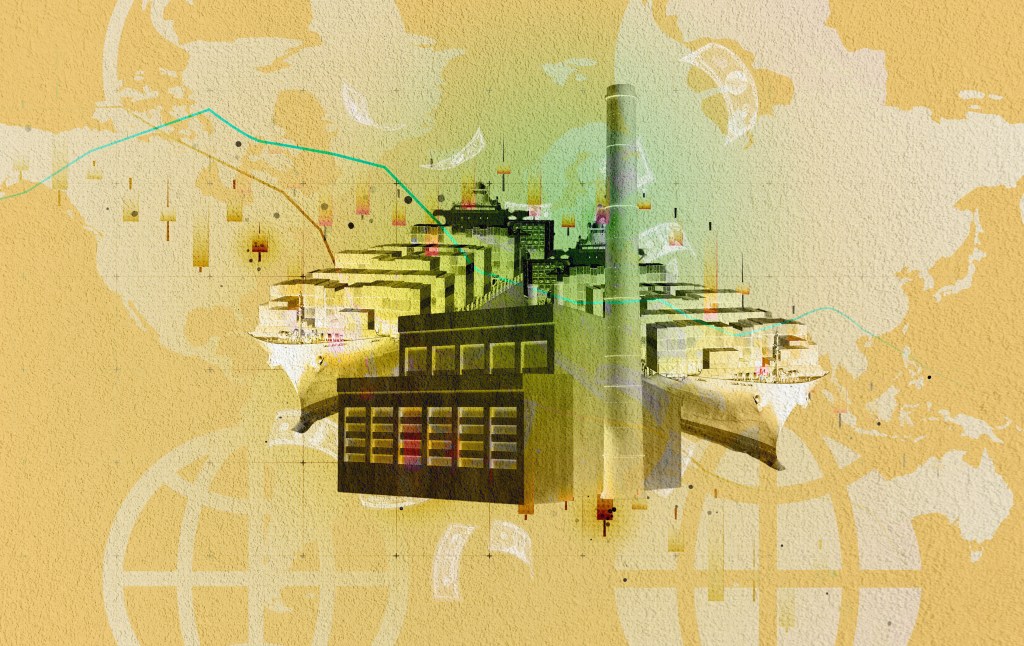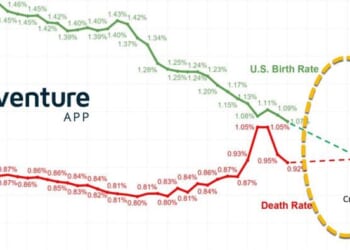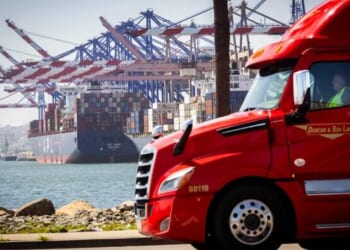
For decades, the working consensus in American politics was that free trade was good. Every Republican presidential nominee from Gerald Ford to Mitt Romney supported agreements to expand and liberalize international trade. Democrats have historically been a bit more reluctant, but their most successful presidents of the last 50 years—Bill Clinton and Barack Obama—both championed free trade and pursued large, multilateral trade agreements. Both the vote to create NAFTA in 1993 and the vote to grant China permanent normal trade relations passed on a bipartisan basis.
That changed in 2016. Hillary Clinton broke with the Obama administration to oppose the Trans Pacific Partnership, and Donald Trump tore up the GOP’s traditional views on trade to promote heavily protectionist, anti-trade policies. Trump withdrew from the TPP on his first day in office, and he was the first president in generations to significantly raise America’s tariff level. Joe Biden rolled back some of Trump’s first-term tariffs, such as those on steel and aluminum from Europe, but he left many others in place. And in his second term, Trump has imposed a universal 10 percent tariff on all goods from all countries, announced a wide variety of higher tariffs on specific countries and categories, and even eliminated the de minimis exception for small packages—that $40 T-shirt you bought from Canada now gets a tariff. Tariff levels in 2025 have skyrocketed to levels we haven’t seen since the 1940s.
Economists say Trump’s tariffs are causing economic chaos—higher prices, slower growth, and increased uncertainty with Trump’s frequent changes. And yet, Democrats haven’t come out forcefully for the idea of free trade. Why?
Democrats have long had a complicated relationship with trade. Despite Clinton and Obama championing international trade, significant parts of the Democratic coalition have opposed new trade agreements. Major unions fiercely opposed TPP, a free trade agreement among 12 Pacific Rim nations including Japan, Australia, Vietnam, Peru, and Chile, with AFL-CIO President Richard Trumka calling it “a new low.” And the populist, anti-capitalist left has always been skeptical of globalization and free trade, from the 1999 WTO protests in Seattle to Elizabeth Warren and Bernie Sanders opposing TPP.
Even after Trump mainstreamed protectionism inside the GOP, prominent Democrats often chose to meet him where he stood rather than draw a sharp contrast. Senate leader Chuck Schumer publicly urged Trump to “hang tough on China.” Ohio’s Sherrod Brown backed Trump’s steel and aluminum tariffs. The shift on trade was so thorough that the Biden administration even expanded some tariffs on China, including electric vehicles, metals, and semiconductors.
Some of the Democratic shift comes from genuine concern about protecting American jobs or implementing smart industrial policy. And it’s not crazy to argue for supporting key technologies like semiconductors or batteries. But some objections to trade are pure rent seeking, like when steel company CEOs argue for increased steel tariffs. And Democrats have now become timid about saying the basic truth: Tariffs are new taxes that Americans pay, and they typically don’t deliver new jobs or economic growth.
If Republicans are now the party of high tariffs and trade skepticism, Democrats can’t just be the party of “tariffs, but smarter.” America needs at least one of our major parties to stand up, loudly and clearly, for free trade.
The situation is ripe for Democrats to unapologetically champion trade because the damage being done by Trump’s tariffs is real and hitting so many sectors of the economy simultaneously.
Soybean farmers across the country are scrambling after China placed retaliatory tariffs on American soybeans and Chinese buyers stopped purchasing from America altogether. China bought more than $12 billion of American soybeans in 2024, our single largest export to China—but that number has now dropped to zero. Things are so bad that the Trump administration has scrambled to cut an emergency deal with China on soybeans, and has talked about a bailout for farmers who’ve suddenly lost their biggest customer.
It’s not just farmers suffering. American automakers have incredibly complex supply chains that stretch into Mexico and Canada, with thousands of different specialized suppliers who provide the parts and components needed to build a car. They’ve been hit hard, with GM’s profit falling by more than a third due to tariff costs. The chemicals industry is set to lose tens of thousands of jobs as chemical costs rise by 8 to 15 percent due to tariffs—and the list of industries that use chemicals is essentially “all of them.” Apparel retailers are scrambling. So many industries are experiencing so much chaos that Trump’s Commerce Department is doing nonsensical things like classifying condensed milk as a metal—domestic producers of condensed milk face significantly higher input costs due to tariffs on steel and aluminum, and now can’t compete with foreign brands without the protection of tariffs.
The shame of it all is that the one industry that tariffs supposedly protect, manufacturing, is also suffering. The U.S. manufacturing industry has contracted for seven straight months under Trump. This is exactly the opposite of what trade skeptics promised. High tariffs were supposed to usher in a new golden age of manufacturing, but they’re killing American manufacturers instead. More than half of the things America imports from other countries are inputs into goods we make here—raw materials like steel, intermediate components, small parts and electronics, and more. Trump’s tariffs have significantly increased costs for all those inputs, and they’re already forcing some manufacturers out of business. One manufacturer said its tariff costs increased by 4,000 percent and called the tariffs “catastrophic.” The U.S. has lost tens of thousands of jobs in the manufacturing sector since April, and that slide is likely to continue as long as tariff chaos does. Tariffs haven’t saved American manufacturing; they’ve weakened it further.
The economic case for free trade is clear. Tariffs increase prices for consumers, they lower GDP growth and kill jobs, they hit low-income families hardest, and they’re causing economic uncertainty and instability. Economists almost universally oppose tariffs, and the long-run gains from trade dwarf any localized pain. But there’s another reason Democrats should come out aggressively against protectionism—it’s a threat to the rule of law.
Trump is attempting to build an “imperial presidency” in his second term, where he can bypass Congress and rule via executive orders and decrees straight from the White House. Republicans in Congress seem perfectly content to let Trump rule that way. This is evident in his approach to immigration enforcement, his “efficiency” drive with DOGE, and in countless other areas. But it’s perhaps most true when it comes to trade policy. Article I, Section 8 of the Constitution gives Congress the sole power to “collect Taxes, Duties, Imposts and Excises” on foreign countries. Over the years, Congress has passed laws delegating this power to the president in certain circumstances. But Trump has taken a tool meant for emergency measures and illegally used it to pass sweeping tariffs on every country in the world.
An appeals court has already found that most of Trump’s tariffs are illegal. The logic is simple—and the Supreme Court will be hearing arguments in the matter on Wednesday. The International Emergency Economic Powers Act (IEEPA) shifts authority from Congress to the president to regulate economic transactions in the case of “unusual and extraordinary” threats or national emergencies. It would be preposterous to say that our trade partnerships with every country in the world (even those with which we have a surplus) are an unusual and extraordinary emergency, especially since most of those partnerships have been steady over time. And Trump often doesn’t even try to pretend that the “emergency” is real—he recently increased tariffs on Canada simply because they hurt his feelings in an advertisement.
Democratic voters want their party to stand up to Trump. Over and over, polling finds that the Democratic base wants to see its party fighting, vigorously resisting Trump’s attempts to make himself a king. What better place to start than with tariffs, where the Constitution explicitly says Congress, not the president, has power? Democrats should loudly demand that Congress reassert control over trade policy, and they should do it in the context of taking power away from the President.
Large majorities of Americans oppose Trump’s tariffs, and the vast majority of Democrats do so. There’s been a significant backlash to the tariff increases, and a majority of Americans (including the majority of independents) now say the U.S. should pursue global free trade. Democratic politicians have mostly denounced the chaos of Trump’s tariffs, but they’ve been far too cautious about promising to roll them back and not nearly aggressive enough about standing up for free trade. They’re treating trade like it’s a trap, but it’s not a trap. It’s an opportunity.
Democratic leadership may be trying to appease labor unions by not going all in on free trade. But the harsh reality is that Democrats are already losing organized labor, and handing out goodies to labor groups doesn’t work. Joe Biden was the most pro-union president in generations. He was the first ever president to walk a picket line, he issued a great number of executive orders mandating or favoring union labor, and he bailed out the Teamsters Union pension fund. What did Democrats get for all that effort? The Teamsters refused to endorse Biden or Harris, their president spoke at the Republican National Convention, and Teamster members favored Trump over Harris almost 2 to 1. Sherrod Brown, one of the party’s most pro-labor and anti-trade voices, continues to lose union endorsements to his GOP opponent in his bid to return to the Senate.
Blue-collar union workers are already leaving the Democratic Party, largely over cultural issues. Offering a mealy-mouthed, half-hearted defense of tariffs isn’t going to bring them back.
Instead, Democrats should loudly proclaim what’s obvious—tariffs are bad policy, and Trump’s tariffs in particular are wrecking the economy. Job growth is abysmal and falling into the negatives. Prices are up, as are the odds of recession—and there’s an obvious villain for Democrats to blame. Going hard against Trump’s tariffs would be good politics for the Democratic base, which wants to see a fight, and it would be good politics for winning independents as well.
Tariffs don’t have to be an exclusionary test for party membership. If Democrats in Midwestern swing districts feel the political need to promote a bit of protectionism, that’s fine. Jared Golden is one of the more tariff-friendly Democrats in Congress, but he knows his Maine district better than I do. And frankly, any Democrat who can win a Trump+10 seat can do whatever the hell they want. But aside from the odd case here and there, Democrats should be embracing free trade.
What would this look like? Democrats should loudly, publicly, repeatedly make the case that tariffs are taxes on the middle class. They should demand an end to Trump’s tariffs, promise to reverse them as soon as they regain power, and demand that trade policy return to its constitutionally appointed place with Congress. Safe-seat Democrats should lead the charge here, alongside party leadership. They should make the affirmative argument that free trade is good. The alternative is a quiet protectionist drift. It’s not out of the question that when Democrats regain power, they let the issue slide, codifying Trump’s damaging policies and moving toward a bipartisan protectionist consensus. America needs at least one free trade party. If Democrats fail to seize that mantle, it would be a tragic misstep that harms productivity, raises costs for the middle class, and deepens the trend toward an imperial presidency.

















